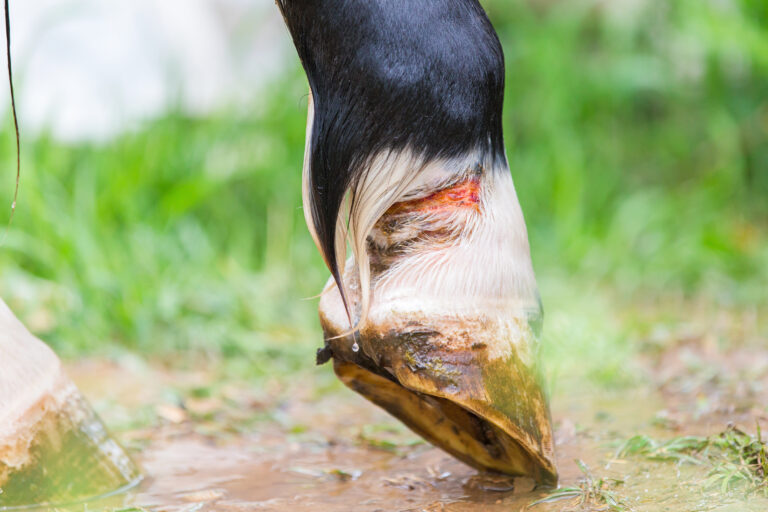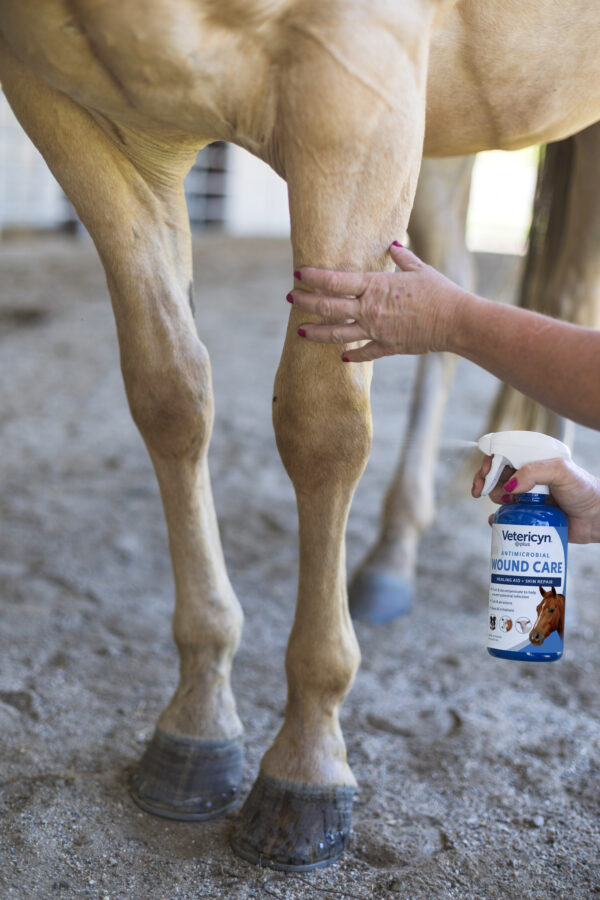Most enthusiasts know that when it comes to horses, it’s not a matter of if they’re going to get hurt–it’s just a matter of when.
Fortunately, most of their cuts, scrapes, and injuries end up being minor wounds that you can treat at home. So how can you tell these cuts apart from larger wounds that warrant a visit to the vet? And how can you care for a horse wound at home?
We’ve created this simple, step-by-step guide to help you do just that.
How to Treat a Cut, Abrasion, or Open Wound on a Horse
#1 Stop the Bleeding
First and foremost, you need to stop any bleeding. While panicking is a natural reaction to seeing blood in your horse’s coat, it’s important to stay calm. This way, you can have your wits about you as you assess the wound.
Depending on the severity of the open wound, you may need to apply pressure on it with a clean cloth towel for 20 minutes to an hour.1 Most minor wounds will stop bleeding within this time frame.
If your horse’s bleeding doesn’t stop, give your vet a call right away.
#2 Assess the Severity of the Wound
Once the wound has stopped bleeding, it’s time to determine if you can care for it effectively at home. To do so, ask yourself the following questions:
- Is your horse in visible pain?
- Is his or her temperature, pulse, and respiration (TPR) normal?
- Is he or she exhibiting any signs of lameness?
- Is the wound surface-level, shallow, or deep?
- Does the cut appear to be a puncture wound?
- Is the wound located near your horse’s eyes, joints, or tendons?
If your horse is in a lot of pain, exhibiting abnormal TPR symptoms, or showing signs of a deep cut or puncture wound, you should leave the treatment to your vet. These are all indications of a more serious injury. You should also defer to your vet for equine wounds involving the eyes, joints, and tendons. Additionally, sudden lameness in one hoof could be a sign of abscesses in horses, which will need to be cared for differently.
As you wait for the vet to arrive, stay by your horse’s side and make sure they can’t cause further harm to themselves.
#3 Treat the Wound

If you’ve decided to treat your horse’s wound yourself, the next step is to gently flush it out with Vetericyn Plus Equine Wound Care. This healing aid will clean and decontaminate to help prevent infection and wash away any large debris. This allows you to see the depth of the cut more clearly.
Once you know how deep the wound is, you can care for it accordingly.
Here’s how you can treat the following types of cuts:
- Scrapes – Scrapes are the most common type of injury horses get in the pasture. Usually, the coat over their scrape will shear off, exposing the skin underneath. This skin may be a little inflamed, similar to in the case of horse rashes.
Since scrapes are surface-level scratches, they generally heal quickly on their own and don’t present much risk of infection. However, it’s still important to rinse the scrape with clean water to get any grit or dirt out of it.
- Minor cuts – If the wound is deeper than a scratch but still relatively shallow, you may be dealing with a minor cut.
To treat it, start by flushing it out with a wound and skin care treatment. This will moisturize the surrounding skin and help prevent any infection from developing. Next, cover the healing wound with a clean bandage to keep dirt out. You should change this bandage daily until the wound is almost healed.
As the healing process works its magic, keep a close eye on the wound for any signs of infection, like swelling or foul-smelling discharge. If you notice any signs of a potentially infected wound, inform your vet right away.
- Deep cuts or puncture wounds – Deep cuts and puncture wounds caused by a foreign object can lead to life-threatening infections and other complications. As a result, their treatment should be left to your vet’s more experienced hands, who may give your horse stitches or administer a tetanus booster.
#4 Watch Out For Complications
No matter who treats your beloved horse, it’s important to keep an eye out for complications during the wound healing process, including:
- Tendon or ligament injuries
- Skin loss
- Proud flesh2
- Infections
Monitor the healing wound closely until your horse is totally back to normal.
Give Your Horse the Very Best

Owning a horse is a rewarding experience. You two share a special bond of trust that goes both ways. By tending to your horse’s wounds swiftly and effectively, you can show it just how much you care.
Whether you’re looking for horsefly bite treatment or to soothe sweet itch in horses, Vetericyn can help you with the horse wound care process. Our Equine Wound & Skin Care Liquid is an essential addition to any equine first aid kit. This safe, non-toxic treatment can clean, flush, and moisturize your horse’s wound, whether it’s a cut, scrape, rope burn, or bite. It’s also free of antibiotics, so you can safely use it on your horse.
With Vetericyn’s help, you can give your horse the exceptional wound care it deserves.
Sources:
- VCA Animal Hospital. First Aid for Wounds for Horses. https://vcahospitals.com/know-your-pet/first-aid-for-wounds-for-horses
- New England Equine Medical and Surgery Center. Equine Proud Flesh. https://www.newenglandequine.com/Articles/EquineProudFlesh.pdf